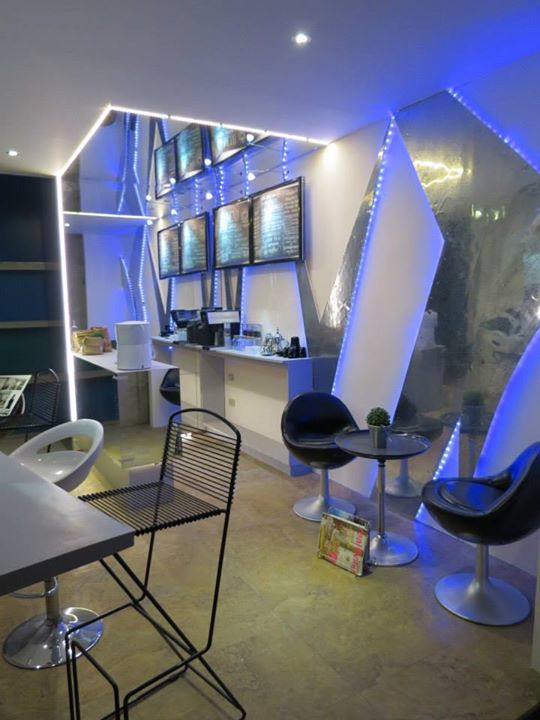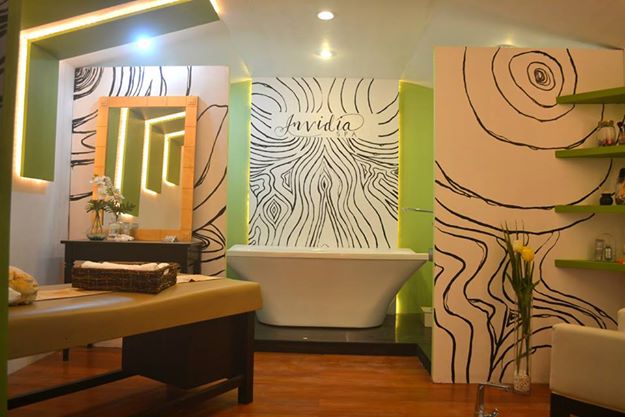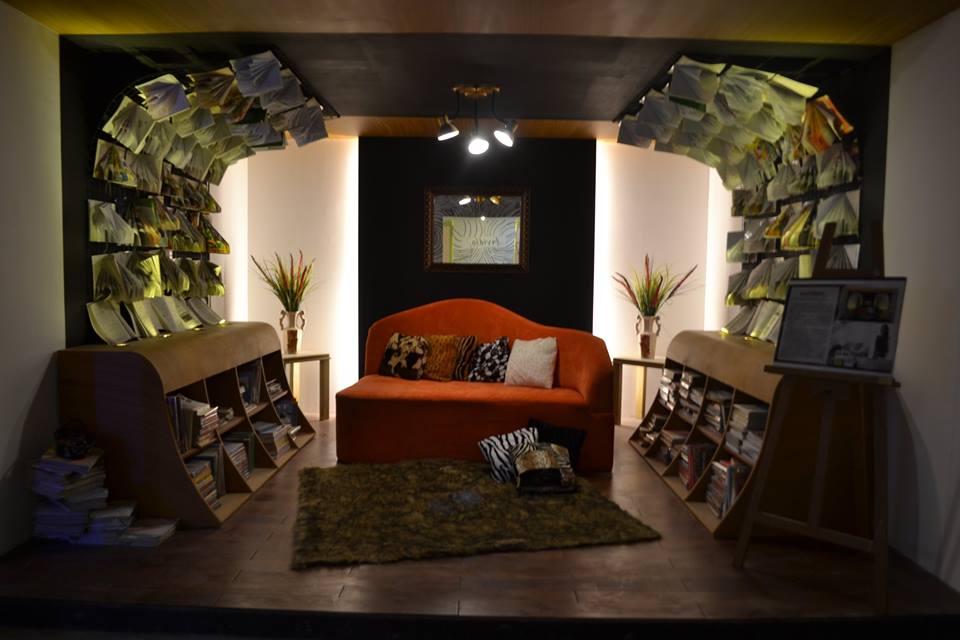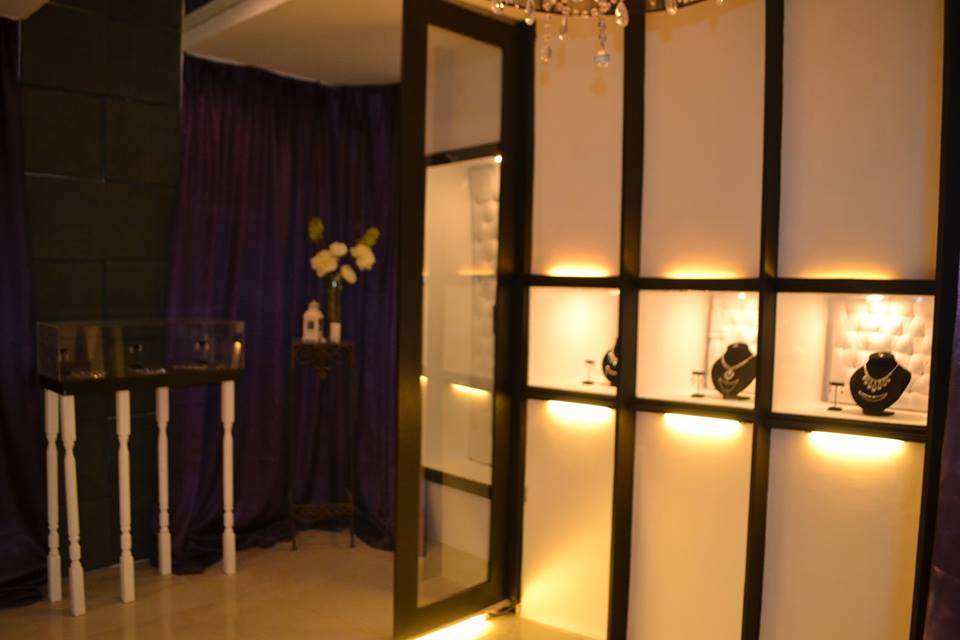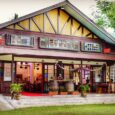The Seven Deadly Sins: An Interior Design Exhibit
Last January 13, 2015, the MAPUA Institute of Technology, School of Architecture, Industrial Design and the Built Environment held an interior design exhibit at the 2nd floor, Alphaland Makati Place, Ayala Avenue with a very interesting theme entitled, The Seven Deadly Sins.
Upon entering the event’s venue shows you the seventh sin which is greed; you will see huge panel evoking selfishness. Panel is made out of wood framing, white satin cloth that suggests innocence or hypocrisy, and garters projected from top to bottom that suggests the intellectual and financial problems that one can encounter when he’s being greedy. There’s also an AVP playing upon entering the venue showcasing the exhibit’s theme, photos of the 6 exhibitors and the sin that was assigned to each of them. You will also see pedestals which symbolizes hands that catches the raining wealth desire with a Philippine 25 cent coins glued on top of it serves as the pedestals for the brochures or flyers of the sponsors. Pedestals are in black that evokes guiltiness. White and gold cloth for the ceiling. Industrial look exposed bulb randomly drops everywhere to adapt to venue’s exposed plenum, and it evokes raining of wealth which a greedy person desires. Red carpet flooring that suggests comfort in being wealthy. Different sizes of golden Styrofoam balls scattered on the floor symbolizes limitless wants if driven by greediness and different kinds of greediness.
The dean of the said college, Gloria B. Teodoro is of course present in the said event. Some of the attendees are the exhibitors’ professors, Professors Kristine Muñoz and Professor Pauline Cuevas Bato. Special guest speaker is Ms. Tina Periquet, an interior architect and principal designer of Periquet Galicia who also delivered a very inspirational and personal talk on how to reach their goals and pursue their passion as a designer. She also provided some tips and useful advice after each of the exhibitors explained the concept of their booth.
Joan Aguilar – Anger
iamjoanaguilar@gmail.com
Title : The Edge Café
The design for this café explores the dual nature of the deadly sin, Anger. As much as it seen as a force that is irrational and unpredictable, the destruction it wreaks is also a necessary condition for creation.
Anger as a double-edged sword becomes main concept for the booth design, and is translated in its iconography through the use of irregular forms and angles that “angrily” slash through the space. But it is the destruction of the open space plans that allows the emergence of intimate and compartmentalized spaces within the café.
The design also employs as an approach anamorphic art that further reinforces this duality, as certain angles keep you from seeing a unified picture of the interior, yet specific vantage points allow you to see it in its entirety. The translation of destruction and creation in this interior provides a highly illusory and conceptual space that is both familiar and disconcerting at the same time lending a highly unpredictable interior space.
Jamila Basas – Envy
jamila.basas@yahoo.com
Title: The Beauty of Invidia
Arising from a feeling of dissatisfaction, the sin Envy is the desire to have what one lacks, whether it is a perceived superior quality, achievement or possession. But is envy really as bad as people actually perceive it? Or can it be a positive driver to help us become a better version of ourselves?
Through borrowed elements from scenography and theater design, a spa becomes the ideal setting upon which to explore the dynamics and dialectics of Envy. Spaces, such as these are stages that play up and on people’s body image, perceptions and insecurities. As a spa can present an ideal of beauty, it can also undermine a person’s self-esteem in the process of doing so by reinforcing feelings of inferiority and lack, thereby inducing feelings of envy towards the ideal—The Other.
The proposed design downplays Envy by promoting a healthy self-image, through the acceptance of transient and flawed beauty. To interpret the essence of the sin, contrasting features are used such as: curve and straight lines, soft and hard textures, natural and synthetic materials, opaque and transparent, matte and shiny, light and dark colors and asymmetry and irregularity.
The various spaces within the spa’s VIP are differentiated through dividers which become symbolic of a step-by-step renewal that takes place within the confines of the spa as well as people’s fragmented perceptions of themselves. At the end of the space, a canopied tub becomes the center stage where the person renewed, rejuvenated, and whole may emerge.
Room dividers also extend to form proscenium arches, each of which are then covered in incomplete views of the ideal beauty echoing people’s incomplete views of their own beauty. It is only looking at the design of the booth, symbolic of our very selves that we realize its wholeness and completeness, our imperfections and flaws as part of our true and ideal selves
Mary Cajayon – Gluttony
maryrosecajayon@rocketmail.com
Title: Hunger for knowledge
Although considered as the least grave of the deadly sins, Gluttony is generally associated with the excessive consumption of food and drink. When a glutton is preoccupied with this, he/ she closes the mind to reason. It is in the rejection of reason that gluttony becomes more prone to other sins, such as greed, and blind to the wanton wastefulness of the act of consumption. In its essence, gluttony is also interpreted as selfishness, essentially placing one’s own interest above everyone else’s.
The booth, “A Hunger for Knowledge” looks at an alternate definition of gluttony, holding up a mirror to a practice that modern society has now preoccupied itself—the hoarding of information and knowledge.
In this information-obsessed age, gluttony is translated in the design of a home library that is filled to the brim with books, literature and paraphernalia associated with knowledge. Yet all this abundance is wasted as placement of these objects are done in a manner that renders these objects useless, wasteful and impractical.
The booth design takes inspiration from various artworks depicting the image of the glutton—corpulent and insatiable. Rotund and curvilinear forms suggestive the engorged belly of the glutton.
Irish Guevarra– Sloth
rishguevarra@gmail.com
Title : Seeking the Truth
What does it mean to be a sloth these days? Is it enough to be physically lazy? Or does sloth take on a much deeper meaning? (Title) takes on a different interpretation of the deadly sin, Sloth. In an age where people are exposed to a multiplicity of culture, religions and beliefs, plurality becomes the overarching concept people go by these days.
The vignette takes a critical look at the concept of plurality and religious relativism. Relativism is a concept that states that points of view have no absolute truth or validity, having only relative, subjective value according to different perception and consideration.
At a philosophical level, plurality and relativism in themselves become akin to spiritual sloth or laziness. It is the equivalent of sitting on a fence, and the refusal to adhere to an Absolute Truth. We become spiritually lazy. It is sloth masquerading as tolerance and open-mindedness.
The concept of relativism employs the translation and stylization of the iconic features of the main belief systems of Catholicism, Islam and Taoism, and looking at the common threads of the major faiths to create a coherent design for a commercial bar design.
Olive Miguel – Lust
via.design03@yahoo.com
Title: Femme Fatale
An exposition of the deadly sin, lust, this vignette seeks to project the nature of the sin, and the various ways in which it finds expression. It looks at the very essence of the sin, which is desire, and asks, “How do we desire? And when does desire begin?”
Using the art of seduction as a central theme, the vignette slowly unfolds, starting with narrow vertical slits on its façade, where viewers are literally given a sneak peek of the interiors, highly suggestive of the act of voyeurism. It makes a direct link to the active way of seeing and looking, and understand it as the beginning of desire—we covet what we see.
To heighten desire, the viewer is enticed and invited to explore further, through the placement and configuration of the jewelry display, which are coyly shielded from direct view. There is a deliberate layering of space that seeks to delay reward, as if a dancer slowly shedding one veil at a time. Objects of desire are kept in shadow boxes and niches on the wall, tempting the viewer but protected from being touched, reinforcing what everyone know about the nature of desire—we want what we cannot have.
The design evokes a strong sense of sensuality through the use of curvilinear forms as well as soft illumination to induce an ambience that is both romantic and mysterious, playing on the emotional and psychological aspects and perception of desire. Likewise, the sense of touch is also awakened to complete the seduction ritual as soft, rich velvet cover the accent wall, creating both visual and tactile textures that are begging to be touched.
As the booth aims to engage the viewer in a discourse on lust through a spatial experience, it asks these final questions: “is lust even a sin? Or a necessary evil?”
Anna Jean Angeles – Pride
Title: Above all else
In almost every list, the sin pride is considered the most serious of the Seven Deadly Sins, from which all other sins originate. It can be understood as self-importance and undue self-love that seeks attention unto oneself and sets the prideful person above everyone and everything else.
This narcissistic behavior is more than mere self-absorption; it leads to the failure to acknowledge the accomplishments of other people nor their sound qualities. The narcissist’ inflated ego and pride convinces himself that he is superior to everybody, while he shuts everything and everyone he may perceive as a threat to his self-image and esteem.
Anchoring on the qualities of the narcissist, (booth title) likens it to a tornado, perhaps one of the most thrilling and dangerous calamities in the natural world. A violent whirling vortex of wind, a tornado ravages, dominating everything in the landscape and leaving nothing standing in its wake.
A bedroom is chosen as the apt setting where this drama can unfold. The bed is both stage and centerpiece that puts to fore the correlation being made between the narcissist and the tornado. The placement of the bed on a raised platform suggests the elevated status on which the narcissist places himself. Overhead, a canopy and the surrounding area mimics the violent rotating winds of the tornado suggesting the self-absorbed nature of the narcissist consuming everything in its path.
Complementing the form of the tornado are textural and chromatic elements that further imply the personal comfort and convenience upon which a narcissist places a premium. Meanwhile, jagged pieces of mirror randomly line the walls to signify the chaos and damage that ensues with relating with a narcissist, all the while casting back the one thing that the narcissist can truly love—his reflection.
Some of the major sponsors of this event are Matimco Floorings, Boysen Paint, Philstar.com, DZXL Radio and TV 5 Buhay OFW.
This is an exhibit open to the public and is a month long exhibit which will last until February 12, 2015. Feel free to visit the venue from 9 AM to 8 PM. Hope to see you there!


